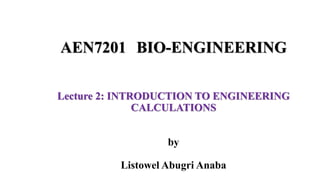This document provides an introduction to engineering calculations, specifically in the context of bio-engineering. It covers essential topics such as physical variables, units of measurement, dimensional homogeneity, and stoichiometry, all crucial for effective quantitative analysis in engineering. The lecture also emphasizes the importance of understanding both metric and non-metric units, unit conversions, and the significance of various natural and substantial variables in engineering calculations.







































